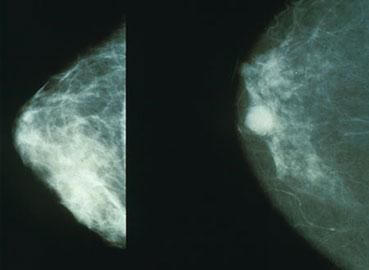This topic takes on average 55 minutes to read.
There are a number of interactive features in this resource:
 Biology
Biology
 Human biology
Human biology
 PSHE / Citizenship studies
PSHE / Citizenship studies
 Science (applied)
Science (applied)
Cancer is not a single disease – there are many types of cancers. What is more scientists are now discovering that cancers mutate and change over time – so the cancer an individual is diagnosed with is not the same as the cancer they many have two years later. Cancer can affect young people and old alike, but it is largely a disease of older people. So as people are living longer, the numbers of people affected by cancer are also increasing all the time.
Cancer cells reproduce without being affected by the normal mechanisms that control the cell cycle and limit their growth. Cancer cells:

Mammograms like these can pick up breast lumps before they can be felt. The right hand image shows a potentially cancerous lump.
(Photo credit: morning2k, Wikimedia Commons)
To treat cancer successfully, it is important to detect the problem as quickly as possible, before the tumour metastases. Unfortunately it often isn’t easy to detect cancers as they grow.
There are many different types of cancers, so what works in treating one cancer will not work for another.
Sometimes cancers form lumps that can be detected on the outside of the body, making detection a bit easier. Breast cancer and testicular cancer are both examples of this. Melanoma forms dark moles on the skin surface.
Sometimes the tumours grow deep inside the body. If there is plenty of room for them to grow before they cause symptoms, they can easily become very big and have formed many metastases before the person affected becomes aware of the problem. This may occur with lung cancers, stomach cancers and bowel cancers for example.
There are a number of different approaches to treating cancer. Some have been used for many years, whilst others involve cutting edge biotechnology. The choice of treatment will depend on the type and stage of the cancer. The ideal treatment attacks and destroys the tumour cells but leaves the healthy cells of the patient intact. No-one has yet found the perfect molecule, but we have an ever-expanding range of treatments to use against different types of cancers.

Tiny cameras that can see inside the body and, along with blood tests, CT scans and MRI, are used to detect cancers forming inside the body
(Photo credit: Dcoetzee, Wikimedia Commons)
In recent years our ability to sequence the human genome has increased dramatically. A process that took years can now be completed in days and costs thousands rather than millions of pounds.
Scientists are using these new techniques in many different ways to try and understand more about the causes of cancer and how it can most effectively be treated. For example: